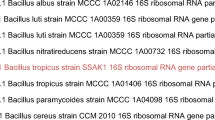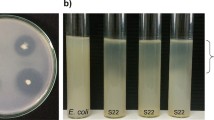Abstract
Purpose
Polyethylene succinate (PES) is a biodegradable synthetic polymer and therefore widely used as a base material in plastic industry to circumvent the environmental problems related with the non-biodegradability of other polymers like polyethylene. Till date only few organisms have been reported to have the ability to degrade PES. Therefore for better management of PES-related environmental waste, the present study is targeted towards isolating mesophilic organism(s) capable of more efficient degradation of PES.
Results
Strain AKS2 was isolated from soil based on survival on a selection plate wherein PES was used as sole carbon source. Ribotyping and biochemical tests revealed that AKS2 is a new strain of Pseudomonas. Scanning electron and atomic force microscopic analysis of the PES films obtained after incubation with AKS2 confirmed PES-degradation ability of AKS2, wherein an alteration in surface topology was observed. The kinetics of PES weight loss showed that AKS2 degrades PES maximally during its logarithmic growth phase at a rate of 1.65 mg/day. This degradation is mediated by esterase activity and may also involve cell-surface hydrophobicity. It has also been observed that AKS2 is able to degrade PES considerably even in the presence of glucose, which is likely to increase the bioremediation potential of this isolate.
Conclusion
A new strain of Pseudomonas has been isolated from soil that is able to adhere to PES and degrade this polymer efficiently. This organism has the potential to be implemented as a useful tool for bioremediation of PES-derived materials.






Similar content being viewed by others
References
Agarwal L, Isar J, Saxena RK (2005) Rapid screening procedures for identification of succinic acid producers. J Biochem Biophys Methods 63:24–32
Ausubel FM, Brent R, Kingston RE, Moore DD, Seidman JG, Smith JA, Struhl K (1994) Current protocols in molecular biology. Wiley, New York
Felsenstein J (1985) Confidence limits on phylogenies: an approach using the bootstrap. Evolution 39:783–791
Hoang KC, Tseng M, Shu WJ (2007) Degradation of polyethylene succinate (PES) by a new thermophilic Microbispora strain. Biodegradation 18:333–342
Holtz JD (1993) Bergey's manual of determinative bacteriology, 9th edn. Williams and Wilkins, Baltimore
Ishii N, Inoue Y, Shimada KI, Tezuka Y, Mitomo H, Kasuya KI (2007) Fungal degradation of poly (ethylene succinate). Polym Degrad Stab 92:44–52
Lowry OH, Rosebrough NJ, Farr AL, Randall RJ (1951) Protein measurement with the Folin phenol reagent. J Biol Chem 193:265–275
Mukherjee K, Tribedi P, Chowdhury A, Ray T, Joardar A, Giri S, Sil AK (2011) Isolation of a Pseudomonas aeruginosa strain from soil that can degrade polyurethane diol. Biodegradation 22:377–388
Rosenberg M, Perry A, Bayer EA, Gutnick DL, Rosenberg E, Ofek I (1981) Adherence of Acinetobacter calcoaceticus RAG-1 to human epithelial cells and to hexadecane. Infect Immun 33:29–33
Tansengco ML, Tokiwa Y (1998) Thermophilic microbial degradation of poly (ethylene succinate). World J Microbiol Biotechnol 14:133–138
Tezuka Y, Ishii N, Kasuya KI, Mitomo H (2004) Degradation of poly(ethylene succinate) by mesophilic bacteria. Polym Degrad Stab 84:115–121
Tokiwa Y, Iwamoto A, Koyama M, Kataoka N, Nishida H (1992) Biological recycling of plastics containing ester bonds. Macromol Symp 57:273–279
Tokiwa Y, Calabia BP, Ugwu CU, Aiba S (2009) Biodegradability of plastics. Int J Mol Sci 10:3722–3742
Vroman I, Tighzert L (2009) Biodegradable polymers. Materials 2:307–344
Acknowledgments
Authors would like to thank Dr. Srimonti Sarkar for her helpful comments and valuable discussions during the tenure of the work. PT is supported by CSIR-Junior Research Fellowship, Government of India. SS is supported by a fellowship from Ministry of Environment and Forest, Government of India. KM is supported by a fellowship from University of Calcutta. This work is supported by a grant-in-aid for scientific research from Department of Science and Technology, Government of West Bengal, India.
Competing interests
Authors declare no conflict of interest.
Author information
Authors and Affiliations
Corresponding author
Additional information
Responsible editor: Philippe Garrigues
Electronic supplementary material
Below is the link to the electronic supplementary material.
Supplementary Fig. 1
AKS2 and AKS9 exhibit similar level of esterase activity. AKS2 and AKS9 were grown to mid-log phase in PES broth and harvested. Lysates were made and pNPA assay was performed utilizing equal amount of protein. Specific activity for each was determined and plotted. U denotes activity of the enzyme. The result represents the average of three independent experiments. Error bar indicates standard deviation (±SD) (JPEG 4 kb)
Rights and permissions
About this article
Cite this article
Tribedi, P., Sarkar, S., Mukherjee, K. et al. Isolation of a novel Pseudomonas sp from soil that can efficiently degrade polyethylene succinate. Environ Sci Pollut Res 19, 2115–2124 (2012). https://doi.org/10.1007/s11356-011-0711-1
Received:
Accepted:
Published:
Issue Date:
DOI: https://doi.org/10.1007/s11356-011-0711-1




